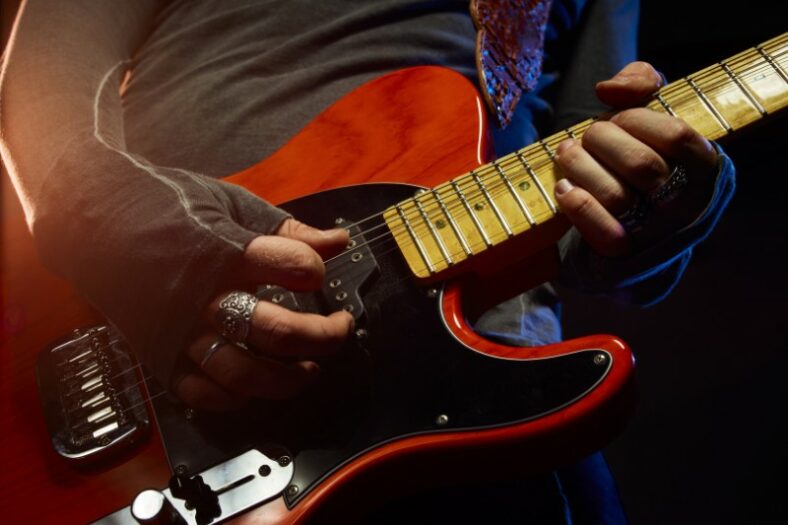7 Improvising Solo Tips For Beginner Guitarists

Playing a jaw-dropping guitar solo is a dream for most beginner guitarists. For soloing, improvisation skills are essential, and developing good improv skills is a long journey. However, there are some easy ways to get started and build solo improvisation foundations.
Every iconic guitar player like Jimmy Page, Jimi Hendrix, Eric Clapton, Joe Satriani, B.B. King, and more have their approach to soloing. Still, they all use different ways of improvisation to create their solos. For soloing, improvisation is a real keystone that every proficient guitarist should be good at.
While it can be hard to improvise solos when you are a beginner, you can start trying by using some limitations, such as staying loyal to just one scale, playing on top of a track that you are really familiar with, and jamming over simple chords.
To develop a good foundation to create jaw-dropping guitar solos and improvise freely, you can take advantage of these tips when you practice.
Contents
Improvising Solo Tips
1. Learn The Scales
Improvising a guitar solo requires good knowledge of musical theory, especially chords and scales. A scale is a sequence of notes within one octave that creates harmony when played together. When improvising, you can use different scales and emphasize notes in the scale to create musical phrases.
Although you can use notes out of the scale when soloing or use different scales in different sequences, it is necessary to know the scale you are playing in. Learning the scales by heart and knowing which notes to play or not is a crucial step.
You can start by learning the pentatonic scales, which feature the easiest patterns and are the most common scales in popular music. You can also take advantage of the so-called “CAGED” system, which makes finding the notes in the scale throughout the fretboard easier.
2. Stay Within The Scale
When starting to improvise solos as a beginner, it is better to stay on one scale you have already mastered. This way, you can feel more comfortable creating different musical phrases and not think about which notes to use and emphasize.
Staying in one scale allows you to focus on the basics of improvisation instead of thinking about other scales or different notes to play. With a single scale, you can progress with your mastery of the scale, which can help you to understand the nuances between the notes and how to use them for building interesting and unique solos with good musical phrases.
Try to learn all the positions of a single scale throughout the fretboard and try to play different positions when jamming to get more comfortable on the fretboard within a scale. Learn where the root notes are located and which chords are playing at the moment. If the chord playing at the moment is an A major, try to emphasize the A note. This way, you can make your solo more melodic and in harmony with the music.
3. Focus On The Picking Pattern
Improvising solos does require not only melodic approaches but also rhythmic character. You must focus on the picking pattern to stay in the rhythm and create different rhythmic grooves. Stay loyal to alternate picking with the up-down-up-down pattern to make things easier.
While there are many different picking patterns you can use while soloing, using the alternate picking with the traditional up-down-up-down pattern is more convenient for beginners and builds up a fundamental trait.
Alternate picking is the most important picking technique, as it helps you grow speed and efficiency when playing. Most beginners try to play their riffs mainly with downstrokes, which can lead you to lose rhythm, speed, and efficiency. So, force yourself to play your licks with the alternate picking, even if you have to play slower to build a solid foundation before moving on to other picking techniques.
4. Implement Subtle Embellishments
Subtle embellishments such as slides, bends, hammer-ons, pull-offs, and vibratos are the little spices that make a mundane lick sound pretty tasty. Using these techniques from time to time can make your solos shine and sound much more professional.
There are many different ways to play the same note on the guitar. Using different phrasing techniques like bends or vibratos will make your solo sound more interesting and less monotonous. So, try to add vibratos, bends, hammer-ons, pull-offs, and slides here and there without overusing them. These subtle embellishments will create a huge difference in how your solo sounds.
Embellishments are not only different techniques but are also stops and silences. So, instead of trying to fill all the spaces with notes, give your solo spaces to breathe and create contrast while playing. You can use long-sounding notes or silent spaces to achieve that.
5. Don’t Rush!
When learning a new skill on an instrument, the most important thing is not to rush and start slowly to build a proper technique. Using a slow BPM or a backing track and gradually progressing will help you build a solid foundation and prevent learning anything in the wrong way.
Most beginner guitarists try to play fast before building a solid technique and understanding, which leads to many mistakes and learning techniques in the wrong way. It is difficult to change something once it has been encoded into muscle memory.
So, it is crucial to start with a slow BPM on your metronome or jam on a slow backing track while playing improvised solos. You can gradually get faster as you feel more comfortable and are sure that you are playing with a good, proper technique. Paradoxically, the fastest way to learn is to go as slow as possible with firm steps.
6. Experiment With Different Guitar Phrases, Scales, and Arpeggios
If you want to be a proficient improviser when playing guitar solos, you have to have different weapons in your arsenal. Experimenting with different guitar phrases, scales, and arpeggios that you are not used to will force you to get out of your comfort zone and learn new things that will come in handy.
Do not limit yourself to your favorite genres and guitarists but try to listen to different genres, musicians, and playing styles to get inspired by. For example, if you are a hard rock listener and do not know any blues scales, you will be missing a lot in your solos. It is highly beneficial to enrich your vocabulary with different licks, techniques, and phrases of different genres to use in your own improvisations.
For example, even though Led Zeppelin is a hard rock band, Jimmy Page uses many licks, scales, and techniques of different styles, such as blues and country, in his riffs and solos. So, experimenting with different guitar phrases, scales, and arpeggios will make you a more complete guitarist and make your solos much richer.
7. Morph Phrases Together When Practicing
Solos are stories with different musical sentences put together. To improvise a good solo, you have to have a rich vocabulary of phrases, and you have to know how to morph them together to create a good story. So, learning different phrases and practicing them all together is a great exercise.
You can start by learning different phrases from different solos and practicing them individually until you are comfortable playing the licks and getting a good understanding of them. If you struggle with the licks, you can break them down into small sections to practice, like one or two bars at a time. As always, start with a slow tempo until you can properly play it before increasing the speed.
Later, you can start morphing the sections together to have the phrase in your repertoire. Do the same process with different phrases until you have a good collection of them to use in your improvisations.
When you have enough phrases, try to improvise by morphing the phrases together and creating an entire guitar solo. Experiment with different phrases in different orders, and try to play the solo in different keys and different speeds to get more comfortable.
Learning To Play By Ear
Learning to play by ear is a great advantage for improvising as it allows you to create your unique licks and melodies. Improvising is mainly about being able to react to the music playing and experimentation, which can be trained and improved with a good musical ear.
To train your ear, the first thing you can try is to learn songs by ear. Try to break the song up into sections and start from the most easily recognizable part of the song, which is generally the chorus. Try to find the root note of the song and try to figure out the scale to find the other notes in the song. Start experimenting with the pentatonic scales, as they are the easiest ones.
When you find the scale and the root note, you can now try to play on top of it. Try to find and emphasize the root notes in the chord progression, which will be the anchors of your solo. If the chord is a B minor, try to emphasize the B note and try to build your phrases on top of these anchors.
What is improvisation?
Improvising a guitar solo means playing a solo performance created spontaneously. A guitarist creates melodies, musical phrases, shapes, and riffs while playing the solo, which has little to no prior preparation or planning.
Although improvisation is mostly spontaneous, it does not mean a guitarist can play freely whatever they want in the solo. There are structures to follow, like the scales, chords, and the rhythmic aspect of the song the solo is played on top. So, improvising requires a mastery of musical theory and instrument technique.
Are there any exercises to improve improvising?
As improvisation is mainly about creativity, there isn’t a specific exercise to play to improve your improvisation skills. But there are methods to work with that can help you on the way. Improving improvisation skills is an individual path, and practicing and experimenting are the best exercises.
Conclusion
So, to create awe-inspiring solos to any music playing, the best thing is to practice and go slowly step-by-step to build a solid foundation and rich vocabulary of different guitar licks and techniques as well as a mastery of harmony knowledge. Try not to rush and take it slowly. As said before, paradoxically, the fastest way to improve improvisation skills is to go as slow as possible with firm steps.





